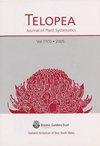标题澳大利亚北部细穗木藻和大穗木藻及其3个近缘新种的重新记录
IF 0.5
4区 生物学
Q4 PLANT SCIENCES
引用次数: 1
摘要
水蛭属植物。复杂(subg。Polypompholyx;是一个形态和生态变化密切相关的分类群,主要分布在澳大利亚北部的热带地区。最近的一项分子系统发育研究将公认的物种U. kamienskii F.Muell。隶属于U. leptorhyncha O. Schwarz或U. lasiocaulis的一个分支的姐妹,后者先前被限定为高度可变形态的组合。我们扩大了先前的研究,包括代表所有三种已知分布的种群,并试图包括所有形态变异;基于rps16、trnD-T两个非编码叶绿体区域和核糖体内部转录间隔区(ITS),对55个组内材料进行了系统发育分析。我们发现,通常开白色花的卡米恩斯基的粉红色花冠形态差异不大,我们将其保留在该物种下。此外,我们还发现了一个全葡萄型的leptorhyncha,其中较小的花品种与所有其他U. lasiocaulis的姊妹型材料相匹配,包括一个先前被指定为较大花的U. leptorhyncha的类群。在U. lasiocaulis分支中,我们发现许多变异分类为支持良好的分支,我们发现这些分支在形态和遗传上与类型分支有足够的区别,可以在特定的等级上识别,即北领地和昆士兰的Utricularia brennanii R.W.Jobson & Baleeiro,西澳大利亚金伯利地区的Utricularia cowiei R.W.Jobson & Baleeiro,和美国分离的r.w.约翰逊和巴莱罗仅限于北领地的达尔文和海湾地区。本文章由计算机程序翻译,如有差异,请以英文原文为准。
Recircumscription of Utricularia leptorhyncha and U. lasiocaulis and three related new species for northern Australia
The Utricularia lasiocaulis F.Muell. complex (subg. Polypompholyx; sect. Lasiocaules) is a morphologically and ecologically variable group of closely related taxa with a mostly tropical distribution across northern Australia. A recent molecular phylogenetic study placed the recognised species U. kamienskii F.Muell. sister to a clade of accessions relegated to either U. leptorhyncha O. Schwarz or U. lasiocaulis, with the latter previously circumscribed as an assemblage of highly variable morphological forms. We have expanded the previous study to include populations representing the known distributions of all three species and have attempted to include all morphological variants; 55 ingroup accessions were used in the full phylogenetic analysis based on two non-coding chloroplast regions (rps16, trnD–T) and the nuclear ribosomal internal transcribed spacer (ITS). We found that the pink corolla form of the usually white flowered U. kamienskii is not sufficiently different, and we retain it under that species. We also found strong support for a paraphyletic U. leptorhyncha, with the smaller flowered accessions matching the type material placed sister to all other U. lasiocaulis forms, including a grouping previously assigned as a larger flowered U. leptorhyncha. Within the U. lasiocaulis clade we found that much of the variation sorts into well-supported clades that we find are sufficiently morphologically and genetically differentiated from the type clade for recognition at the specific rank, namely Utricularia brennanii R.W.Jobson & Baleeiro from Northern Territory and Queensland, Utricularia cowiei R.W.Jobson & Baleeiro from the Kimberley region of Western Australia, and U. disjuncta R.W.Jobson & Baleeiro restricted to the Darwin and Gulf region of the Northern Territory.
求助全文
通过发布文献求助,成功后即可免费获取论文全文。
去求助
来源期刊

Telopea
PLANT SCIENCES-
CiteScore
1.30
自引率
42.90%
发文量
0
期刊介绍:
Manuscripts submitted for publication in TELOPEA are published online, after peer review and acceptance by the TELOPEA Editorial Committee and when final editorial formatting has been completed. The journal specialises in plant systematics and phylogeny. The geographic scope of the journal encompasses Australia, Malesia, Melanesia, Micronesia, and Polynesia. The suitability of a work for the journal depends on the topic and the region of origin, generally the narrower the focus of the manuscript the closer to New South Wales must be its geographic focus.
As a general guide, we will consider:
1) revisionary treatments and other substantial bodies of work from any of the regions mentioned above.
2) new species from any Australian state.
3) new country records for Australia from any state.
4) new state records from New South Wales only.
However, we aim to support botanical research across the broader Australasian and Pacific region, and will consider submissions on their merit.
Generally we will not consider extraterritorial new country records, or single lectotypification papers unless they pertain to New South Wales taxa, or have significant bearing on the Australian flora.
 求助内容:
求助内容: 应助结果提醒方式:
应助结果提醒方式:


